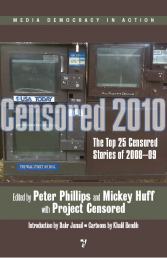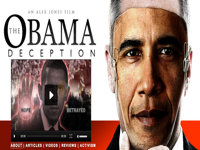Posts Tagged ‘bbc’
Wikipedia is one the project we like more. It contains millions of informations of any type: a real democratic online enciclopedia, where everyone can write.
Yes… just everyone… Our question: and if governments or institutions or agencies dislike wikipedia’s voice, what can they do?
The answer is in a post of gionark, an italian blogger, based on a BBC article, from which we extract something (we can think that the war of information and disinformation between USA, CIA, Vatican, BBC, CNN and etc., may results in useful informations like this):
“An online tool that claims to reveal the identity of organisations that edit Wikipedia pages has revealed that the CIA was involved in editing entries.“
On the profile of Iranian President Mahmoud Ahmadinejad, the tool indicates that a worker on the CIA network reportedly added the exclamation “Wahhhhhh!” before a section on the leader’s plans for his presidency.
A warning on the profile of the anonymous editor reads: “You have recently vandalised a Wikipedia article, and you are now being asked to stop this type of behaviour.”

It is claimed the entry was changed by a CIA computer user |
Other changes that have been made are more innocuous, and include tweaks to the profile of former CIA chief Porter Goss and celebrities such as Oprah Winfrey.
When asked whether it could confirm whether the changes had been made by a person using a CIA computer, an agency spokesperson responded: “I cannot confirm that the traffic you cite came from agency computers.
“I’d like in any case to underscore a far larger and more significant point that no one should doubt or forget: The CIA has a vital mission in protecting the United States, and the focus of this agency is there, on that decisive work.”
The site also indicates that a computer owned by the US Democratic Party was used to make changes to the site of right-wing talk show host Rush Limbaugh.
The changes brand Mr Limbaugh as “idiotic,” a “racist”, and a “bigot”. An entry about his audience now reads: “Most of them are legally retarded.”
The IP address is registered in the name of the Democratic National Headquarters.
… The site also indicates that Vatican computers were used to remove content from a page about the leader of the Irish republican party Sinn Fein, Gerry Adams.
The edit removed links to newspaper stories written in 2006 that alleged that Mr Adams’ fingerprints and handprints were found on a car used during a double murder in 1971.
Wikipedia Scanner also points the finger at commercial organisations that have modified entries about the pages.
One in particular is Diebold, a company which supplies electronic voting machines in the US.
BBC News website users contacted the corporation to point out that the tool also revealed that people inside the BBC had made edits to Wikipedia pages.
The last sentence is quite incredible: BBC writes that it changed something on Wikipedia… there is no way to know if we’ll ever have a democratic knowledge… in the meantime we can only write what we see.
 bbc, CIA, disinformation, life, manipulation, news, politics, vatican
bbc, CIA, disinformation, life, manipulation, news, politics, vatican
“Propaganda is neutrally defined as a systematic form of purposeful persuasion that attempts to influence the emotions, attitudes, opinions, and actions of specified target audiences for ideological, political or commercial purposes through the controlled transmission of one-sided messages (which may or may not be factual) via mass and direct media channels. A propaganda organization employs propagandists who engage in propagandism—the applied creation and distribution of such forms of persuasion.“
– R.A. Nelson, A Chronology and Glossary of Propaganda in the United States, 1996
“Propaganda is the deliberate, systematic attempt to shape perceptions, manipulate cognitions, and direct behaviour to achieve a response that furthers the desired intent of the propagandist.”
– Garth S. Jowett and Victoria O’Donnell, Propaganda And Persuasion
From wikpedia:
“What separates propagandism from “normal” communication is in ways by which the message attempts to shape opinion or behavior, which are often subtle and insidious among other characteristics. For example, propagandism is often presented in a way that attempts to deliberately evoke a strong emotion, especially by suggesting illogical (or non-intuitive) relationships between concepts or objects (for instance between a “good” car and an attractive woman or a sex symbol).”
It’s clear that if media or talk shows wants to support the government, they don’t need to say it clearly… they can use subliminal messages or simply evoke a strong emotion on you. Do you want to know how to manipulate your mind? From Wikipedia:
A number of techniques which are based on social psychological research are used to generate propaganda. Many of these same techniques can be found under logical fallacies, since propagandists use arguments that, while sometimes convincing, are not necessarily valid.
Some time has been spent analyzing the means by which propaganda messages are transmitted. That work is important but it is clear that information dissemination strategies only become propaganda strategies when coupled with propagandistic messages. Identifying these messages is a necessary prerequisite to study the methods by which those messages are spread. Below are a number of techniques for generating propaganda:
- Ad Hominem: A Latin phrase which has come to mean attacking your opponent, as opposed to attacking their arguments.
- Appeal to authority: Appeals to authority cite prominent figures to support a position, idea, argument, or course of action.
- Appeal to fear: Appeals to fear seek to build support by instilling anxieties and panic in the general population, for example, Joseph Goebbels exploited Theodore Kaufman‘s Germany Must Perish! to claim that the Allies sought the extermination of the German people.
- Appeal to Prejudice: Using loaded or emotive terms to attach value or moral goodness to believing the proposition. For example, the phrase: “Any hard-working taxpayer would have to agree that those who do not work, and who do not support the community do not deserve the community’s support through social assistance.”
- Argumentum ad nauseam: This argument approach uses tireless repetition of an idea. An idea, especially a simple slogan, that is repeated enough times, may begin to be taken as the truth. This approach works best when media sources are limited and controlled by the propagator.
- Bandwagon: Bandwagon and “inevitable-victory” appeals attempt to persuade the target audience to join in and take the course of action that “everyone else is taking.”
- Inevitable victory: invites those not already on the bandwagon to join those already on the road to certain victory. Those already or at least partially on the bandwagon are reassured that staying aboard is their best course of action.
- Join the crowd: This technique reinforces people’s natural desire to be on the winning side. This technique is used to convince the audience that a program is an expression of an irresistible mass movement and that it is in their best interest to join.
- Black-and-White fallacy: Presenting only two choices, with the product or idea being propagated as the better choice. (e.g., “You are either with us, or you are with the enemy”)
- Beautiful people: The type of propaganda that deals with famous people or depicts attractive, happy people. This makes other people think that if they buy a product or follow a certain ideology, they too will be happy or successful. (This is more used in advertising for products, instead of political reasons)
- Big Lie: The repeated articulation of a complex of events that justify subsequent action. The descriptions of these events have elements of truth, and the “big lie” generalizations merge and eventually supplant the public’s accurate perception of the underlying events. After World War I the German Stab in the back explanation of the cause of their defeat became a justification for Nazi re-militarization and revanchist aggression.
- Common man: The “‘plain folks’” or “common man” approach attempts to convince the audience that the propagandist’s positions reflect the common sense of the people. It is designed to win the confidence of the audience by communicating in the common manner and style of the target audience. Propagandists use ordinary language and mannerisms (and clothe their message in face-to-face and audiovisual communications) in attempting to identify their point of view with that of the average person. For example, a propaganda leaflet may make an argument on a macroeconomic issue, such as unemployment insurance benefits, using everyday terms: “given that the country has little money during this recession, we should stop paying unemployment benefits to those who do not work, because that is like maxing out all your credit cards during a tight period, when you should be tightening your belt.”
- Demonizing the enemy: Making individuals from the opposing nation, from a different ethnic group, or those who support the opposing viewpoint appear to be subhuman (e.g., the Vietnam War-era term “gooks” for NLF soldiers), worthless, or immoral, through suggestion or false accusations.
- Direct order: This technique hopes to simplify the decision making process by using images and words to tell the audience exactly what actions to take, eliminating any other possible choices. Authority figures can be used to give the order, overlapping it with the Appeal to authorityUncle Sam “I want you” image is an example of this technique. technique, but not necessarily. The
- Euphoria: The use of an event that generates euphoria or happiness, or using an appealing event to boost morale. Euphoria can be created by declaring a holiday, making luxury items available, or mounting a military parade with marching bands and patriotic messages.
- Disinformation: The creation or deletion of information from public records, in the purpose of making a false record of an event or the actions of a person or organization, including outright forgery of photographs, motion pictures, broadcasts, and sound recordings as well as printed documents.
- Flag-waving: An attempt to justify an action on the grounds that doing so will make one more patriotic, or in some way benefit a group, country, or idea. The feeling of patriotism which this technique attempts to inspire may not necessarily diminish or entirely omit one’s capability for rational examination of the matter in question.
- Glittering generalities: Glittering generalities are emotionally appealing words applied to a product or idea, but which present no concrete argument or analysis. A famous example is the campaign slogan “Ford has a better idea!”
- Intentional vagueness: Generalities are deliberately vague so that the audience may supply its own interpretations. The intention is to move the audience by use of undefined phrases, without analyzing their validity or attempting to determine their reasonableness or application. The intent is to cause people to draw their own interpretations rather than simply being presented with an explicit idea. In trying to “figure out” the propaganda, the audience foregoes judgment of the ideas presented. Their validity, reasonableness and application may still be considered.
- Obtain disapproval or Reductio ad Hitlerum: This technique is used to persuade a target audience to disapprove of an action or idea by suggesting that the idea is popular with groups hated, feared, or held in contempt by the target audience. Thus if a group which supports a certain policy is led to believe that undesirable, subversive, or contemptible people support the same policy, then the members of the group may decide to change their original position.
- Oversimplification: Favorable generalities are used to provide simple answers to complex social, political, economic, or military problems.
- Quotes out of Context: Selective editing of quotes which can change meanings. Political documentaries designed to discredit an opponent or an opposing political viewpoint often make use of this technique.
- Rationalization: Individuals or groups may use favorable generalities to rationalize questionable acts or beliefs. Vague and pleasant phrases are often used to justify such actions or beliefs.
- Red herring/Chewbacca Defense: Presenting data or issues that, while compelling, are irrelevant to the argument at hand, and then claiming that it validates the argument.
- Repetition: This type of propaganda deals with a jingle or word that is repeated over and over again, thus getting it stuck in someones head, so they can buy the product.The “Repetition” method has been described previously.
- Scapegoating: Assigning blame to an individual or group, thus alleviating feelings of guilt from responsible parties and/or distracting attention from the need to fix the problem for which blame is being assigned.
- Slogans: A slogan is a brief, striking phrase that may include labeling and stereotyping. Although slogans may be enlisted to support reasoned ideas, in practice they tend to act only as emotional appeals. Opponents of the US’s invasion and occupation of Iraq use the slogan “blood for oil” to suggest that the invasion and its human losses was done to access Iraq’s oil riches. On the other hand, “hawks” who argue that the US should continue to fight in Iraq use the slogan “cut and run” to suggest that it would be cowardly or weak to withdraw from Iraq. Similarly, the names of the military campaigns, such as “enduring freedom” or “just cause”, may also be regarded to be slogans, devised to influence people.
- Stereotyping or Name Calling or Labeling: This technique attempts to arouse prejudices in an audience by labeling the object of the propaganda campaign as something the target audience fears, hates, loathes, or finds undesirable. For instance, reporting on a foreign country or social group may focus on the stereotypical traits that the reader expects, even though they are far from being representative of the whole country or group; such reporting often focuses on the anecdotal.
- Testimonial: Testimonials are quotations, in or out of context, especially cited to support or reject a given policy, action, program, or personality. The reputation or the role (expert, respected public figure, etc.) of the individual giving the statement is exploited. The testimonial places the official sanction of a respected person or authority on a propaganda message. This is done in an effort to cause the target audience to identify itself with the authority or to accept the authority’s opinions and beliefs as its own. See also, damaging quotation
- Transfer: Also known as Association, this is a technique of projecting positive or negative qualities (praise or blame) of a person, entity, object, or value (an individual, group, organization, nation, patriotism, etc.) to another to make the second more acceptable or to discredit it. It evokes an emotional response, which stimulates the target to identify with recognized authorities. Often highly visual, this technique often utilizes symbols (for example, the Swastika used in Nazi Germany, originally a symbol for health and prosperity) superimposed over other visual images. An example of common use of this technique in America is for the President’s image to be overlayed with a swastika by his opponents.
- Unstated assumption: This technique is used when the propaganda concept that the propagandist intends to transmit would seem less credible if explicitly stated. The concept is instead repeatedly assumed or implied.
- Virtue words: These are words in the value system of the target audience which tend to produce a positive image when attached to a person or issue. Peace, happiness, security, wise leadership, freedom, “The Truth”, etc. are virtue words. In countries such as the U.S. religiosity is seen as a virtue, making associations to this quality affectively beneficial. See “”Transfer“”.
There were studies about propaganda and its relationship with media, which lead to manipulation of information against democracy!
“The 20th century has been characterized by three developments of great political importance: the growth of democracy, the growth of corporate power, and the growth of corporate propaganda as a means of protecting corporate power against democracy.” (Noam Chomsky)
“During the 2003 invasion of Iraq, the Iraqi Information Minister Mohammed Saeed al-Sahaf repeatedly claimed Iraqi forces were decisively winning every battle. Even up to the overthrow of the Iraqi government at Baghdad, he maintained that the United States would soon be defeated, in contradiction with all other media. Due to this, he quickly became a cult figure in the West, and gained recognition on the website . The Iraqis, misled by his propaganda, on the other hand, were shocked when instead Iraq was defeated. WeLoveTheIraqiInformationMinister.com
In November 2005, The Chicago Tribune and the Los Angeles Times, alleged that the United States military had manipulated news reported in Iraqi media in an effort to cast a favorable light on its actions while demoralizing the insurgency. Lt. Col. Barry Johnson, a military spokesman in Iraq, said the program is “an important part of countering misinformation in the news by insurgents”, while a spokesman for former Defense Secretary Donald H. Rumsfeld said the allegations of manipulation were troubling if true. The Department of Defense has confirmed the existence of the program. The New York Times published an article about how the Pentagon has started to use contractors with little experience in journalism or public relations to plant articles in the Iraqi press. These articles are usually written by US soldiers without attribution or are attributed to a non-existent organization called the “International Information Center.” Planting propaganda stories in newspapers was done by both the Allies and Central Powers in the First World War and the Axis and Allies in the Second; this is the latest version of this technique.”Full text here.
 bbc, CIA, cnn, corporation, disinformation, Financial, Times, life, manipulation, New, York, news, politics, propaganda, Times
bbc, CIA, cnn, corporation, disinformation, Financial, Times, life, manipulation, New, York, news, politics, propaganda, Times
Who of you ask himself from where informations in the other blogs or in this one come from?
If bloggers only copy news on New York Times, The Times, Financial Times, BBC, CNN, etc., the result is we’ll see a lot of news of the same type. The questions is: and if BBC doesn’t tell about an event, because isn’t good for UK or some friends’ interests?
The same thing we can say for CNN or the others. If you read our post about Bush’s economic interests on Afghanistan, you’ll see that CNN covered with its silence the story about relationship between Bush, Unocal Corporation and Afghanistan talibans. For this reason, read this:
- Abe de Vries “U.S. Army ‘Psyops’ Specialists Worked for CNN,” Trouw, February 21, 2000
- Abe de Vries “The American Army Loves CNN,” Trouw, February 25, 2000
“ Reports in the Dutch newspaper Trouw (2/21/00, 2/25/00) and France’s Intelligence Newsletter (2/17/00) have revealed that several officers from the US Army’s 4th Psychological Operations (PSYOPS) Group at Ft. Bragg worked in the news division at CNN‘s Atlanta headquarters last year, starting in the final days of the Kosovo War…”
“… What makes the CNN story especially troubling is the fact that the network allowed the Army’s covert propagandists to work in its headquarters, where they learned the ins and outs of CNN‘s operations. Even if the PSYOPS officers working in the newsroom did not influence news reporting, did the network allow the military to conduct an intelligence-gathering mission against CNN itself?…”
“…Please write to CNN and ask why the network allowed government propaganda specialists to work in their news division…”
We are the only ones to see this? In these days FAIR wrote:
“The New York Times and Washington Post (11/28/07) both failed to adequately challenge the dishonesty of former President Bill Clinton’s declaration that he had been opposed to the Iraq War “from the beginning.” Clinton, in fact, was a supporter of the war, both before the invasion and in the first year or so of the fighting.”
You can read all the article from which we extract some paragraphs:
“…During the war on Serbia, as with other recent conflicts involving the US, wars, CNN’s screen was filled with an interminable procession of US military officers. On April 27 of last year, Amy Goodman of the Pacifica radio network, put a good question to Frank Sesno, who is CNN’s senior vice president for political coverage.
GOODMAN:”If you support the practice of putting ex-military men -generals – on the payroll to share their opinion during a time of war, would you also support putting peace activists on the payroll to give a different opinion during a time of war? To be sitting there with the military generals talking about why they feel that war is not appropriate?”
FRANK SESNO: “We bring the generals in because of their expertise in a particular area. We call them analysts. We don’t bring them in as advocates. In fact, we actually talk to them about that – they’re not there as advocates.”
Exactly a week before Sesno said this, CNN had featured as one of its military analysts, Lt Gen Dan Benton, US Army Retired.
BENTON: “I don’t know what our countrymen that are questioning why we’re involved in this conflict are thinking about. As I listened to this press conference this morning with reports of rapes burning, villages being burned and this particularly incredible report of blood banks, of blood being harvested from young boys for the use of Yugoslav forces, I just got madder and madder. The United States has a responsibility as the only superpower in the world, and when we learn about these things, somebody has got to stand up and say, that’s enough, stop it, we aren’t going to put up with this. And so the United States is fulfilling its leadership responsibility with our NATO allies and are trying to stop these incredible atrocities.”
Please note what CNN’s supposedly non-advocatory analyst Benton was ranting about: a particularly bizarre and preposterous NATO propaganda item about 700 Albanian boys being used as human blood banks for Serb fighters.”
If a blogger posts news he read from this media, how we can be sure of their authenticity? From Wikipedia: “Authenticity refers to the truthfulness of origins, attributions, commitments, sincerity, devotion, and intentions“.
Is it not enough?
 bbc, CIA, cnn, corporation, disinformation, Financial, Times, life, manipulation, New, York, news, politics, propaganda, Times
bbc, CIA, cnn, corporation, disinformation, Financial, Times, life, manipulation, New, York, news, politics, propaganda, Times



 E-mail Subscribe
E-mail Subscribe


































